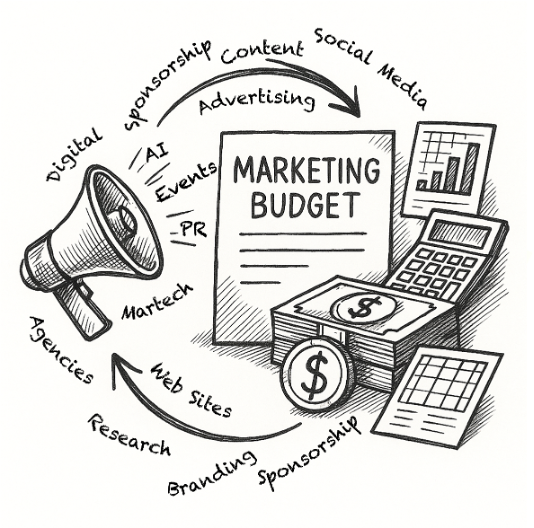Marketing Budget Strategy 2026: Executive Guide to Strategic Investment Planning
Learn how to allocate your 2026 marketing budget using a proven framework,
Eric J. Siano
7/24/20253 min read


Executive Summary: While it may seem early, now is the perfect time to start thinking about your 2026 marketing budget strategy. Marketing investment approaches have fundamentally evolved, with data showing sustained growth and new AI-driven opportunities reshaping how C-suite executives allocate resources.
Current Marketing Budget Benchmarks
Industry Standards and Revenue Allocation
Marketing budgets for 2025 stabilized at 7.7% of overall company revenue according to Gartner research. However, allocation varies significantly by business model:
B2B companies: 8.4% of revenue (recommended range: 2-5%)
B2C companies: 5.7% of revenue (recommended range: 5-10%)
Growth trajectory: 75% of executives expect budget increases, with 20% projecting growth exceeding 20%
Historical Context and Growth Trends
Marketing investment has shown consistent upward momentum:
Fall 2023: 2.6% of revenue
Fall 2024: 5.8% of revenue
Projected next 12 months: 8.6% of revenue
This represents a clear shift from defensive spending to strategic investment in market expansion and technological advancement.
Strategic Framework: The Three-Pillar Budget Model
Pillar 1: Proven Performance (70%)
Allocate the majority of budget to tested, high-ROI activities:
Established digital channels with documented conversion rates
Customer retention and loyalty programs
Core brand marketing initiatives with measurable impact
Pillar 2: Growth Initiatives (20%)
Invest in promising but unproven opportunities:
New channel exploration (emerging social platforms, podcast advertising)
Market expansion efforts
Enhanced personalization capabilities
Pillar 3: Innovation Testing (10%)
Reserve budget for experimental initiatives:
AI-powered marketing technologies
Virtual and augmented reality experiences
Emerging MarTech solutions
AI and Technology Investment Priorities
Current AI Adoption Landscape
20% of marketers now allocate more than 40% of their marketing budget to AI-driven campaigns, with measurable results:
34.1% report significant improvement in marketing outcomes from AI implementation
ROI improvements visible within first quarter of implementation
Enhanced targeting precision reducing cost per acquisition
Strategic AI Integration Areas
Predictive Analytics: Customer behavior forecasting and churn prevention
Personalization Engines: Dynamic content and experience optimization
Automated Campaign Management: Real-time bid optimization and budget allocation
Lead Scoring and Qualification: Enhanced sales pipeline efficiency
Emerging Budget Categories for 2026
Experiential Marketing Resurgence
6.7% projected growth in experiential marketing spend reflects renewed emphasis on:
In-person brand experiences and events
Hybrid digital-physical activations
Community building and relationship marketing
Immersive brand storytelling
Sustainability and Purpose-Driven Marketing
Growing consumer expectations drive budget allocation toward:
Sustainable marketing practices and eco-friendly campaigns
Social impact messaging and corporate responsibility
Transparent supply chain and ethical business communications
ESG-aligned brand positioning
Budget Planning Methodology
Zero-Based Budgeting Approach
Start with zero allocation and justify every investment:
Define Strategic Objectives: Align budget with corporate growth goals
Prioritize High-Impact Activities: Focus on measurable revenue drivers
Validate Through Testing: Require proof-of-concept before major allocation
Build in Flexibility: Reserve 15-20% for mid-year reallocation based on performance
Essential Planning Components
Before budget allocation, develop comprehensive marketing strategy including:
Current Market Position Analysis: Competitive landscape and market share assessment
Target Audience Definition: Detailed customer personas and journey mapping
Channel Performance Benchmarks: Historical ROI data by marketing channel
Technology Infrastructure Needs: MarTech stack requirements and integration costs
Success Measurement Framework: KPIs and attribution models for each initiative
Economic Considerations and Risk Management
External Pressure Factors
94% of advertisers anticipate tariff-related budget impacts, with most projecting 6-10% reductions. Executive teams should:
Diversify Geographic Exposure: Reduce dependence on single markets
Negotiate Flexible Contracts: Build volume discounts and cancellation clauses
Prioritize Owned Media: Invest in channels you control versus rented media space
Develop Scenario Plans: Prepare 10%, 20%, and 30% budget reduction strategies
Inflation Impact Mitigation
With budget growth at 3.3% (down from 5.8% in 2024) while media costs rise:
Focus on Efficiency Gains: Leverage AI and automation to reduce manual costs
Renegotiate Vendor Contracts: Consolidate suppliers for better pricing power
Invest in Customer Retention: Lower cost than acquisition in inflationary periods
Optimize Attribution: Eliminate budget waste through better measurement
Revenue Leadership Recommendations
For Established Companies
Maintain Investment Discipline: Continue proven 70-20-10 allocation model
Accelerate AI Integration: Early adopters maintaining competitive advantage
Strengthen Customer Analytics: Enhanced lifetime value modeling and segmentation
Build Cross-Functional Alignment: Sales and marketing integration for revenue optimization
For Growth-Stage Companies
Invest in Scalable Infrastructure: MarTech stack that grows with business
Focus on Product-Market Fit: Validate messaging before scaling spend
Develop Repeatable Processes: Document successful campaigns for team scaling
Balance Growth and Efficiency: Avoid unsustainable customer acquisition costs
Key Performance Indicators for 2026
Primary Metrics
Customer Acquisition Cost (CAC) by channel and campaign
Customer Lifetime Value (CLV) with predictive modeling
Lead conversion rates and velocity
Brand Awareness and Share of Voice in target markets
Advanced Analytics
Attribution Modeling: Multi-touch revenue attribution across channels
Predictive Scoring: Lead quality and customer success probability
Cohort Analysis: Customer behavior patterns and retention drivers
Competitive Intelligence: Market share trends and competitor activity
Implementation Timeline and Milestones
Q3 2025: Foundation Setting
Complete market analysis and competitive assessment
Finalize 2026 strategic objectives and success metrics
Evaluate current MarTech stack and identify gaps
Begin AI pilot programs in controlled environments
Q4 2025: Budget Finalization
Complete zero-based budget analysis and allocation
Secure vendor contracts and partnerships for 2026
Establish measurement frameworks and reporting systems
Prepare teams for new technology implementations
Q1 2026: Execution and Optimization
Launch priority initiatives with enhanced monitoring
Begin monthly performance reviews and optimization cycles
Scale successful pilot programs based on early results
Prepare mid-year budget reallocation scenarios
Strategic Investment for Sustainable Growth
Marketing budget planning in 2025 requires balancing proven performance with strategic innovation. Executive teams that embrace AI integration, maintain measurement discipline, and build flexible allocation models will achieve sustainable competitive advantage.
The shift from reactive budgeting to strategic investment planning represents a fundamental evolution in how successful companies approach marketing. Organizations that treat marketing as a growth investment rather than a cost center will capture disproportionate market share in an increasingly competitive landscape.
Key Takeaway: Companies allocating 26% of marketing budgets to measurable, revenue-driving activities while investing strategically in AI and emerging technologies position themselves for sustained growth and market leadership.
